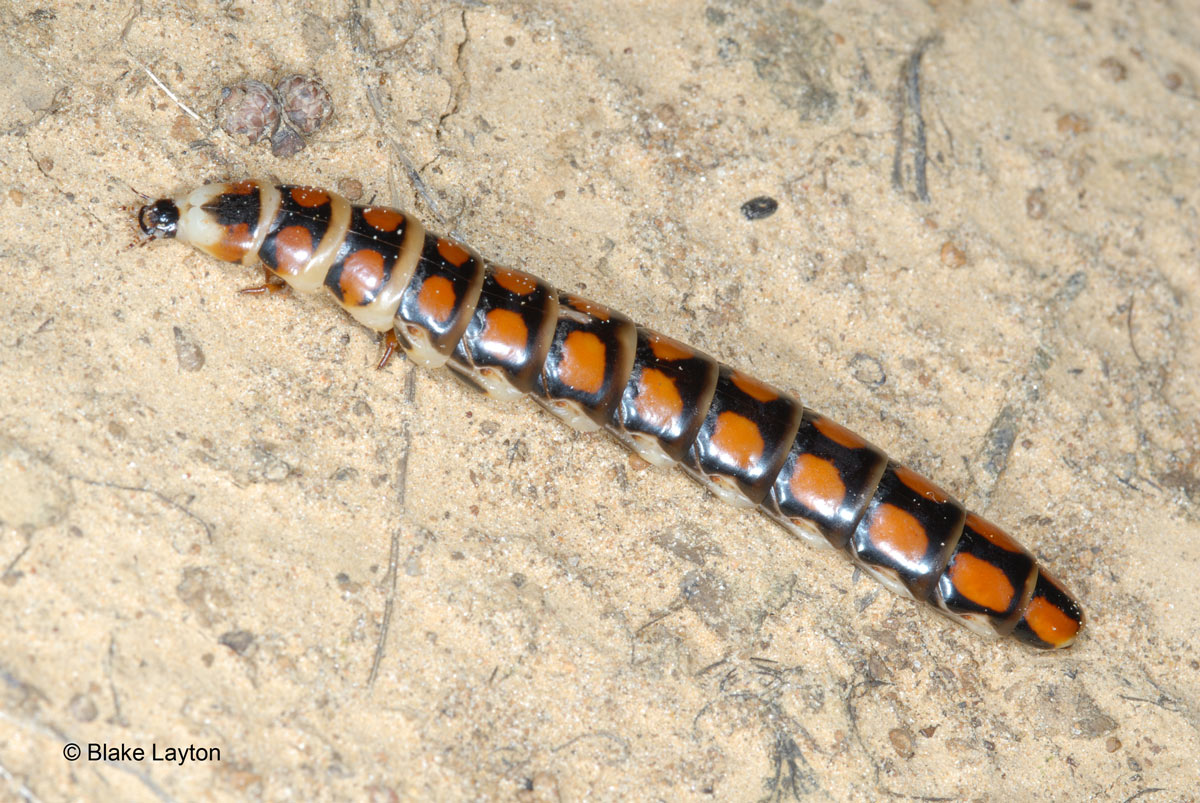Railroad-worm, Vol. 8, No. 11

Phengodes spp.
Order: Coleoptera
Family: Phengodidae
Railroad-worms are some of the strangest insects in the country. That’s a mature female beetle in the photo. Notice she has no wings and looks very unbeetle-like. In fact, she looks just like she did as a larva, except for being larger (about 3 inches). Female railroad worms remain “larviform” after they become sexually mature, a trait they share with some species of fireflies, which despite their name, are also beetles.
Railroad-worms are also called glowworms because they glow in the dark, again a trait they share with fireflies, though they belong to a different family of beetles. All stages of these insects glow, even the eggs and pupae, but large larvae and mature females are most impressive. The greenish-yellow glow is continuous, with spots of light on most body segments and bands of light emanating from between the segments. They got the name “railroad-worm because a large larva or female crawling about at night somewhat resembles a distant passenger train with lights glowing through the windows.
Why do they glow? Unlike fireflies, which use their lights both to find mates and to warn potential predators they are toxic or distasteful, glowworms use their lights primarily as a warning, much like the warning coloration of Monarch butterflies. Males find females by using their unusually large antennae to sense pheromones produced by the females.
Though very different from females, males are equally odd and unbeetle-like. Male glowworms have wings, but the front pair, the elytra, which form that hard protective covering on most beetles, are reduced to stubs, making the translucent, membranous hind wings more visible. The unusually large plumose antennae are the most distinctive feature; they are almost half the length of the body and branched like a fern frond.
Perhaps the strangest thing about railroad-worms is what they eat and how they catch it. Larvae and females are specialized predators of millipedes. Millipedes are formidable prey because of their heavily armored bodies and the fact that many millipedes exude noxious chemicals when they are threatened, with different groups of millipedes producing different types of defensive chemicals. Some even produce hydrogen cyanide.
Railroad-worms routinely feed on millipedes that are as large or larger than they are, including the colorful American giant millipede, which can be up to 4 inches long. First, they track down a millipede, then crawl onto its back before curling their head underneath to bite through the membrane between two of the segments to sever the nerve cord and paralyze their prey. (As with insects, the nerve cord of millipedes is on the underside of their body.) Then they feed leisurely by cutting into the body cavity and feeding on the contents, crawling deeper into the carcass as they feed. This allows them to avoid most of the defensive secretions, which are released to the outside of the body.
Although there are several species and they occur through much of the state, railroad-worms are seldom seen because they spend their days underground or under leaf litter, coming out to hunt by night. Next time you are walking through a shaded, forest environment, keep an eye out for dead millipedes. If you find one that has been cut into about ¼ to 1/3 of the way back from the head and is hollowed out, you are probably looking at the remains of a railroad-worm feast. If you find an area with several of these carcasses and are willing to spend some time watching in the dark, you might even spot a railroad-worm chugging its way through the night.
Blake Layton, Extension Entomology Specialist, Mississippi State University Extension Service.
The information given here is for educational purposes only. Always read and follow current label directions. Specific commercial products are mentioned as examples only and reference to specific products or trade names is made with the understanding that no discrimination is intended to other products that may also be suitable and appropriately labeled.
Mississippi State University is an equal opportunity institution.
Bug’s Eye View is now on Facebook. Join the Bug's Eye View Facebook group here.

